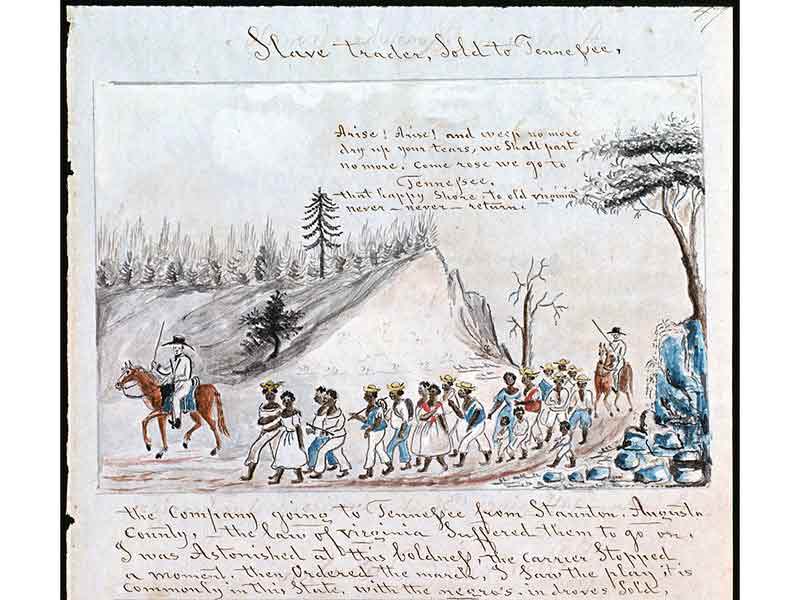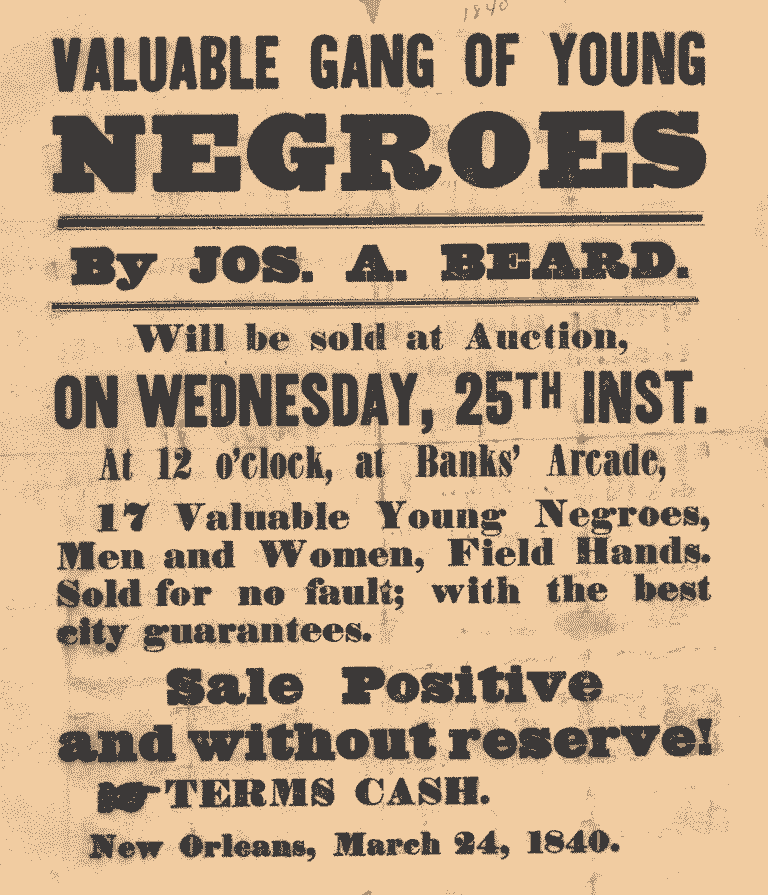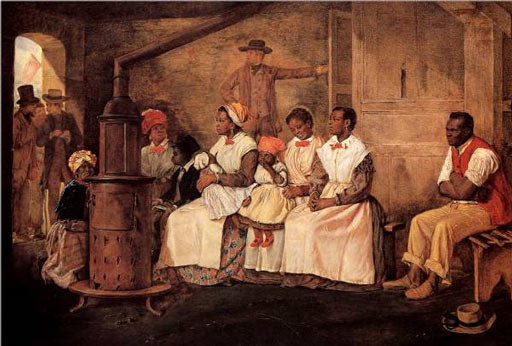7.3: The Domestic Slave Trade
- Page ID
- 22764
The South’s dependence on cotton was matched by its dependence on slaves to harvest the cotton. Despite the rhetoric of the Revolution that “all men are created equal,” slavery not only endured in the American republic but formed the very foundation of the country’s economic success. Cotton and slavery occupied a central—and intertwined—place in the nineteenth‑century economy.
In 1807, the U.S. Congress abolished the foreign slave trade, a ban that went into effect on January 1, 1808. After this date, importing slaves from Africa became illegal in the United States. While smuggling continued to occur, the end of the international slave trade meant that domestic slaves were in very high demand. Fortunately for Americans whose wealth depended upon the exploitation of slave labor, a fall in the price of tobacco had caused landowners in the Upper South to reduce their production of this crop and use more of their land to grow wheat, which was far more profitable. While tobacco was a labor-intensive crop that required many people to cultivate it, wheat was not. Former tobacco farmers in the older states of Virginia and Maryland found themselves with “surplus” slaves whom they were obligated to feed, clothe, and shelter. Some slaveholders responded to this situation by freeing slaves; far more decided to sell their excess bondsmen. Virginia and Maryland therefore took the lead in the domestic slave trade, the trading of slaves within the borders of the United States. (11)
 A group of slaves, also known as a coffle, being marched from Virginia to Tennessee by white slave traders in the domestic slave trade.Figure 7-5: Slave Trader, Sold to Tennessee by Unknown is in the Public Domain .
A group of slaves, also known as a coffle, being marched from Virginia to Tennessee by white slave traders in the domestic slave trade.Figure 7-5: Slave Trader, Sold to Tennessee by Unknown is in the Public Domain .
The text on the image below reads:
(top of drawing)
Arise! Arise! and weep no more dry up your tears, we shall part no more. Come rose we go to Tennessee, that happy shore, to old Virginia never—never—return.
(bottom of drawing)
The Company going to Tennessee from Staunton, Augusta county, – the law of Virginia suffered them to go on. I was astonished at this boldness, the carrier stopped a moment. Then ordered the march, I saw the play it is commonly in this state, with the negro’s in droves Sold.
The domestic slave trade offered many economic opportunities for white men. Those who sold their slaves could realize great profits, as could the slave brokers who served as middlemen between sellers and buyers. Other white men could benefit from the trade as owners of warehouses and pens in which slaves were held, or as suppliers of clothing and food for slaves on the move. Between 1790 and 1859, slaveholders in Virginia sold more than half a million slaves. In the early part of this period, many of these slaves were sold to people living in Kentucky, Tennessee, and North and South Carolina. By the 1820s, however, people in Kentucky and the Carolinas had begun to sell many of their slaves as well. Maryland slave dealers sold at least 185,000 slaves. Kentucky slaveholders sold some seventy-one thousand individuals. Most of the slave traders carried these slaves further south to Alabama, Louisiana, and Mississippi. New Orleans, the hub of commerce, boasted the largest slave market in the United States and grew to become the nation’s fourth-largest city as a result. Natchez, Mississippi, had the second-largest market. In Virginia, Maryland, the Carolinas, and elsewhere in the South, slave auctions happened every day. (11)
 An 1840 advertisement by a slave trader for the sale of slaves at an auction in New Orleans, Louisiana.Figure 7-6: ValuableGangOfYoungNegroes1840 by Jos. A. Beard is in the Public Domain .
An 1840 advertisement by a slave trader for the sale of slaves at an auction in New Orleans, Louisiana.Figure 7-6: ValuableGangOfYoungNegroes1840 by Jos. A. Beard is in the Public Domain .  An 1853 painting by the English artist Eyre Crowe showing African American slaves in a slave market in Richmond, Virginia being auctioned to slave traders.Figure 7-7: Slaves Waiting for Sale – Richmond , Virginia by Eyre Crowe is in the Public Domain .
An 1853 painting by the English artist Eyre Crowe showing African American slaves in a slave market in Richmond, Virginia being auctioned to slave traders.Figure 7-7: Slaves Waiting for Sale – Richmond , Virginia by Eyre Crowe is in the Public Domain .
All told, the movement of slaves in the South made up one of the largest forced internal migrations in the United States. In each of the decades between 1820 and 1860, about 200,000 people were sold and relocated. The 1800 census recorded over one million African Americans, of which nearly 900,000 were slaves. By 1860, the total number of African Americans increased to 4.4 million, and of that number, 3.95 million were held in bondage. For many slaves, the domestic slave trade incited the terror of being sold away from family and friends. (11)
 A map issued by the US Coast Guard showing the percentage of slaves in the population in each county in the slave-holding states of the United States in 1860. The note reads: It should be observed, that several counties appear comparatively light. This arises from the Preponderance of white and free blacks in the large towns in those counties, such as Henrico Co. Va… Charleston Co. S/C, etc. The figures in each county represent the percentage of slaves viz: Amherst Co, Va 46-7/10 are slaves in every 100 inhabitants; Wayne Co, N. Carolina 38-5/10 are slaves in every 100 inhabitants.Figure 7-9: SlavePopulationUS1860 by E. Hergesheimer and Th. Leonhardt is in the Public Domain .
A map issued by the US Coast Guard showing the percentage of slaves in the population in each county in the slave-holding states of the United States in 1860. The note reads: It should be observed, that several counties appear comparatively light. This arises from the Preponderance of white and free blacks in the large towns in those counties, such as Henrico Co. Va… Charleston Co. S/C, etc. The figures in each county represent the percentage of slaves viz: Amherst Co, Va 46-7/10 are slaves in every 100 inhabitants; Wayne Co, N. Carolina 38-5/10 are slaves in every 100 inhabitants.Figure 7-9: SlavePopulationUS1860 by E. Hergesheimer and Th. Leonhardt is in the Public Domain .
Solomon Northup Remembers the New Orleans Slave Market
Solomon Northup was a free black man living in Saratoga, New York, when he was kidnapped and sold into slavery in 1841. He later escaped and wrote a book about his experiences: Twelve Years a Slave. Narrative of Solomon Northup, a Citizen of New-York, Kidnapped in Washington City in 1841 and Rescued in 1853 (the basis of a 2013 Academy Award–winning film). This excerpt derives from Northup’s description of being sold in New Orleans, along with fellow slave Eliza and her children Randall and Emily.
One old gentleman, who said he wanted a coachman, appeared to take a fancy to me… The same man also purchased Randall. The little fellow was made to jump, and run across the floor, and perform many other feats, exhibiting his activity and condition. All the time the trade was going on, Eliza was crying aloud, and wringing her hands. She besought the man not to buy him, unless he also bought her self and Emily… Freeman turned round to her, savagely, with his whip in his uplifted hand, ordering her to stop her noise, or he would flog her. He would not have such work—such snivelling; and unless she ceased that minute, he would take her to the yard and give her a hundred lashes… Eliza shrunk before him, and tried to wipe away her tears, but it was all in vain. She wanted to be with her children, she said, the little time she had to live. All the frowns and threats of Freeman, could not wholly silence the afflicted mother. (11)


